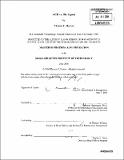| dc.contributor.advisor | Deborah Nightingale. | en_US |
| dc.contributor.author | Hutton, Thomas C., 1965- | en_US |
| dc.contributor.other | Sloan School of Management. | en_US |
| dc.date.accessioned | 2005-06-02T19:06:18Z | |
| dc.date.available | 2005-06-02T19:06:18Z | |
| dc.date.copyright | 2004 | en_US |
| dc.date.issued | 2004 | en_US |
| dc.identifier.uri | http://hdl.handle.net/1721.1/17898 | |
| dc.description | Thesis (M.B.A.)--Massachusetts Institute of Technology, Sloan School of Management, 2004. | en_US |
| dc.description | Includes bibliographical references (leaf 68). | en_US |
| dc.description.abstract | In the early 1980's and 1990's, companies began to build upon the principles of Total Quality Management and developed there own unique quality systems. The most popular and well known of these systems is Six Sigma that was developed by Motorola and successfully adopted by others such as Allied Signal (now Honeywell) and most notably, General Electric. Six Sigma can be characterized as a highly formalized, process oriented improvement tool that is data focused. The Six Sigma process is normally performed by a diverse team, who attack a quality/process problem by analyzing process variation or in statistical terms, sigma. The foundations of Six Sigma are commitment from upper management, detailed training and a regimented diagnostic approach. Another quality operating system is the less known, but very successful, Achieving Competitive Excellence (ACE) operating system. This system was developed and is practiced by United Technologies Corporation (UTC). The ACE system is broader based than the Six-Sigma approach, however, ACE is not as data oriented as the Six Sigma approach. ACE revolves around the three principle categories of process improvement and waste elimination tools, decision-making tools, and problem solving tools. These tools impact issues as diverse, but not limited to, factory floor cleanliness, market feedback analysis, machine tool preventative maintenance and set up reduction. ACE is a combination of lean manufacturing and quality improvement philosophies. This paper provides an analysis of both the Six Sigma and ACE Quality Operating Systems. In the paper the systems are compared and contrasted. Further, strengths and weaknesses of each system are discussed. In particular, the analysis focuses on how ACE can leverage elements | en_US |
| dc.description.abstract | (cont.) and aspects of Six Sigma. The analysis concludes that there are elements of Six Sigma that would benefit ACE. The paper identifies that the strength of Six Sigma's statistical approach and its positive impact on process certification could be beneficially applied to the ACE system. Further, there are recommendations for UTC to place more of an emphasis on ACE training and to accelerate its current efforts to better link quality and lean improvement to product engineering and design. | en_US |
| dc.description.statementofresponsibility | by Thomas C. Hutton. | en_US |
| dc.format.extent | 68 leaves | en_US |
| dc.format.extent | 2860945 bytes | |
| dc.format.extent | 2860751 bytes | |
| dc.format.mimetype | application/pdf | |
| dc.format.mimetype | application/pdf | |
| dc.language.iso | eng | en_US |
| dc.publisher | Massachusetts Institute of Technology | en_US |
| dc.rights | M.I.T. theses are protected by copyright. They may be viewed from this source for any purpose, but reproduction or distribution in any format is prohibited without written permission. See provided URL for inquiries about permission. | en_US |
| dc.rights.uri | http://dspace.mit.edu/handle/1721.1/7582 | |
| dc.subject | Sloan School of Management. | en_US |
| dc.subject.lcsh | Six sigma (Quality control standard) | en_US |
| dc.title | ACE vs. Six Sigma | en_US |
| dc.title.alternative | Achieving Competitive Excellence versus Six Sigma | en_US |
| dc.type | Thesis | en_US |
| dc.description.degree | M.B.A. | en_US |
| dc.contributor.department | Sloan School of Management | |
| dc.identifier.oclc | 56673335 | en_US |
